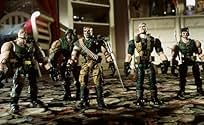You hear it first, that small clack of plastic feet on tile, the whirr of a motor that sounds too strong for a toy.
In a blink, the living room turns tactical and the couch fort needs reinforcements. Small Soldiers takes a harmless toy box and asks what happens when the chips inside were meant for something else.
Joe Dante keeps the suburb ordinary and lets the toys get loud.
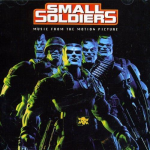
The Commando Elite talk like veterans. The Gorgonites look for home. It has that PG-13 edge that makes you sit up. Live actors carry the story, while voices from Tommy Lee Jones and Frank Langella give the figures a presence you feel.
The images land because the toys occupy the frame.
Practical puppets share shots with CGI, a blend Dante pegged at roughly one-third puppetry and the rest digital. The result is tactile and a little alarming, like a figure that might scrape your knuckles if you grab it wrong.
Jerry Goldsmith’s score is the pulse under the chaos, steady and propulsive. It’s the quiet engine that keeps the living room battle moving.
And the late 90s marketing swirl is part of the memory. Burger King handed out toys while the film landed a PG-13, prompting a printed disclaimer that the movie might not suit younger kids, with some counters offering a Mr. Potato Head swap. Cute on the tray, trouble on the screen.
Here’s the roadmap.
We’ll look at how this tiny riot was built, why its satire hits harder now that “smart” gadgets sit in every room, and how these small warriors proved that little things can make a very big mess.
Joe Dante released the film in July 1998.
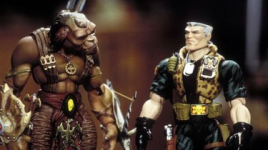
The core idea is simple and sharp: a military-grade chip, the X1000, brings two toy factions to life and sets them on a collision course.
Visually it mixes practical puppetry with CGI, a choice Dante described as roughly one third puppetry and the rest digital. That blend makes the toys feel physical and a little threatening.
The tone mattered.
It played like a summer kid movie and pushed sharper satire about marketing and militarism, which became obvious when tie-in toys and Burger King promotions rolled out during a PG-13 summer. That mismatch sparked real conversation.
What starts as a toy-adventure quickly becomes a tidy satire about corporate overreach and militarized tech slipping into everyday life. In the story, GloboTech’s X1000 microprocessor (meant for defense work) accidentally powers two toy lines, the militaristic Commando Elite and the peaceful Gorgonites, and that mismatch drives everything that follows.

That premise gives Dante room to toggle tones.
The script lets the Commando Elite behave like soldiers with real tactics, while the Gorgonites are coded to be curious and gentle. So the movie can be silly, and then sudden and sharp. It asks you to laugh at plastic soldiers while also nudging you to notice who built the chips and why.
The PG-13 rating made the point louder in the real world.
With Burger King handing out promotional toys, parents and critics noticed the mismatch between tie-in marketing and the movie’s darker beats. The controversy underlined the movie’s central tension: cute products, tough content, and the corporate machinery that puts them together.
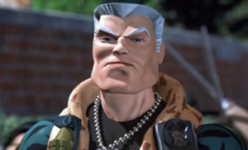
He talks like a career officer and moves with ruthless efficiency, which makes him funny and a little terrifying at the same time. Tommy Lee Jones lends the voice, bringing that dry, bull-dog cadence that turns a gag into an order you obey.
What sticks is the mismatch between size and intent.
Chip commands a squad with military doctrine, but his toolkit is a kid’s accessory set and some duct-taped garage weapons. That mismatch is the joke and the threat.
He is the movie’s main antagonist, but also the clearest probe of the film’s bigger idea: what happens when military hardware and marketing swap notes and end up in your house. The result is a villain who is comically grand and oddly believable, the kind you remember long after the toys are put away.
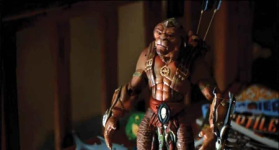
Frank Langella gives him a low, lion-like voice that reads older and wiser than his plastic frame, which turns a goofy puppet into something you care about.
The Gorgonites were meant to be educational and curious, not combative, so Archer spends much of the film protecting his people and trying to find their home. That contrast with the Commando Elite sharpens the whole idea: one side trained to fight, the other built to learn and belong.
Archer’s scenes land because he feels like the moral axis, the toy version of a weary neighbor who bakes casseroles and still knows how to read a map. When he speaks, you believe the Gorgonites have a shot at surviving, and that makes the stakes feel real even when everything else is small and loud.

Played by Gregory Smith, Alan starts as a curious kid with a knack for tinkering, the kind of kid who can turn a pile of garage junk into a rolling menace or a clever escape vehicle.
What matters is his arc.
He moves from collector to protector, shifting loyalties when he sees what the Commando Elite do. He’s the one who understands the Gorgonites are not toys to be exploited, and he uses his hands-on skills to level the playing field.

Kirsten Dunst plays her with a mix of curiosity and backbone that makes Christy more than a background crush; she becomes essential to the rescue plan and the film’s moral center.
She starts as an ordinary kid next door who notices Alan’s tinkering and slowly trusts him.
When the Commando Elite escalate things and take hostages, Christy’s courage shifts the story; she moves from damsel-in-distress to active participant in freeing her family and outsmarting the toys.
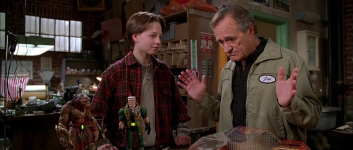
He starts as a typical suburban dad, a bit frazzled but hardworking. When the Commando Elite escalate, Phil moves fast from baffled parent to improvised problem solver, the kind who clamps down on panic and figures out the next step.
His value is in grounding the chaos.
While kids and toys drive the spectacle, Phil’s reactions give the film a human pulse. He doesn’t deliver heroic lines. Instead he makes small choices that matter, like protecting his family, reading a situation, and trusting the kids enough to let them act.
That humility keeps the stakes believable. Phil is comic relief without being a buffoon, the dad you’d want nearby if your living room suddenly became a war zone.
The creatures were built to look real, not cartoonish props, so when they move you accept them as physical actors in the room. Dante used practical puppets alongside CGI, a choice he later summed up as about one third puppetry and the rest computer work.
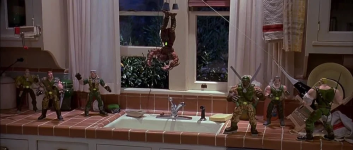
The voice cast pours gravity into plastic.
Frank Langella’s Archer gives the Gorgonites a weary dignity, while Tommy Lee Jones and others make the Commando Elite sound like actual combat veterans. Those performances turn jokes into threats and toys into characters you can respect or fear.
Sound ties it together.
Jerry Goldsmith’s score underpins the action, and the soundtrack (rock and hip hop mixed) landed in July 1998, giving the film a pulse that kept the living-room battles from ever feeling small.
Even the merchandise reflected that care.
Kenner made toy lines that looked and moved like the film versions, and video games followed quickly, so the movie’s visual and audio design echoed out into the toys and play at home.
Burger King ran promotional toys the same summer the film carried a PG-13 warning, and some restaurants even offered swaps for milder items after complaints. That real-world mismatch turned a marketing push into part of the conversation about the movie.
Critics were split.
The film made roughly $72 million worldwide on a $40 million budget, so it did alright at the box office, but reviews flagged the tonal tug between kid-friendly spectacle and sharper satire. Audiences who wanted a straight kids’ romp left stirred; viewers who caught the satire found more to chew on.
Merchandise and tie-ins followed quickly, from Kenner toy lines to video games, which kept the film alive in playrooms even as debates about its target age lingered.
Kenner pushed out toy lines that looked like the movie versions, and four video games landed in 1998 across PlayStation, PC, and Game Boy, so the film’s little wars lived on in bedrooms and on CRT screens.
The film also seeded later work.
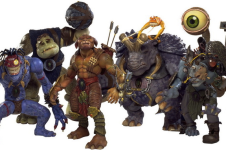
Indie devs say Small Soldiers inspired ideas for modern shooters, and you can trace a thread from its DIY garage-vehicle spirit to games that lean into toy-scale combat.
Home video and streaming kept the movie circulating.
It hit VHS and DVD in late 1998, later Blu-ray, and a 4K steelbook arrived in 2025; it’s also shown up on services like Paramount+ and Pluto TV, which helps new audiences rediscover the odd mix of satire and toy-mayhem.
And the “what if” never died.
A Toymageddon remake went into development in the 2010s but was cancelled after studio acquisitions, which is a reminder that Hollywood still thinks these tiny uprisings are worth revisiting, even if the follow-up never materialized.
Why it matters now is simple.
The film’s joke about military tech in toys reads differently in an era of smart speakers and learning devices on every shelf. Small Soldiers asks, in a late-90s voice, what happens when the gadgets you trust were built for other purposes.
That question is why, two decades later, the movie still clicks when you push “play.”
It made you laugh, then nudged you to notice how military thinking, marketing, and code can slip into a living room without much fanfare. That blend of craft, satire, and straight-up weirdness is why the movie still snaps into focus when you press play.
If you watch it now you’ll see practical effects that still feel alive, voice work that gives plastic weight, and a joke about tech that reads eerily current. It reminds us that small things can change the story in a hurry, and that attention matters more than ever when toys start behaving like tools.
Think of it as a cautionary pop fable, but one you still want on your shelf. The tiny riot keeps teaching us how to pay attention.
In a blink, the living room turns tactical and the couch fort needs reinforcements. Small Soldiers takes a harmless toy box and asks what happens when the chips inside were meant for something else.
Joe Dante keeps the suburb ordinary and lets the toys get loud.

The Commando Elite talk like veterans. The Gorgonites look for home. It has that PG-13 edge that makes you sit up. Live actors carry the story, while voices from Tommy Lee Jones and Frank Langella give the figures a presence you feel.
The images land because the toys occupy the frame.
Practical puppets share shots with CGI, a blend Dante pegged at roughly one-third puppetry and the rest digital. The result is tactile and a little alarming, like a figure that might scrape your knuckles if you grab it wrong.
Jerry Goldsmith’s score is the pulse under the chaos, steady and propulsive. It’s the quiet engine that keeps the living room battle moving.
And the late 90s marketing swirl is part of the memory. Burger King handed out toys while the film landed a PG-13, prompting a printed disclaimer that the movie might not suit younger kids, with some counters offering a Mr. Potato Head swap. Cute on the tray, trouble on the screen.
Here’s the roadmap.
We’ll look at how this tiny riot was built, why its satire hits harder now that “smart” gadgets sit in every room, and how these small warriors proved that little things can make a very big mess.
How The Riot Began: Making The Movie
I remember leaning forward on the couch the first time a toy really moved and felt like it meant business. Small Soldiers turns that tiny surprise into the whole movie.Joe Dante released the film in July 1998.

The core idea is simple and sharp: a military-grade chip, the X1000, brings two toy factions to life and sets them on a collision course.
Visually it mixes practical puppetry with CGI, a choice Dante described as roughly one third puppetry and the rest digital. That blend makes the toys feel physical and a little threatening.
The tone mattered.
It played like a summer kid movie and pushed sharper satire about marketing and militarism, which became obvious when tie-in toys and Burger King promotions rolled out during a PG-13 summer. That mismatch sparked real conversation.
The Story, and Why Small Soldiers Wasn’t Just For Kids
There’s a moment in the film where the joke stops landing and the point lands instead.What starts as a toy-adventure quickly becomes a tidy satire about corporate overreach and militarized tech slipping into everyday life. In the story, GloboTech’s X1000 microprocessor (meant for defense work) accidentally powers two toy lines, the militaristic Commando Elite and the peaceful Gorgonites, and that mismatch drives everything that follows.

That premise gives Dante room to toggle tones.
The script lets the Commando Elite behave like soldiers with real tactics, while the Gorgonites are coded to be curious and gentle. So the movie can be silly, and then sudden and sharp. It asks you to laugh at plastic soldiers while also nudging you to notice who built the chips and why.
The PG-13 rating made the point louder in the real world.
With Burger King handing out promotional toys, parents and critics noticed the mismatch between tie-in marketing and the movie’s darker beats. The controversy underlined the movie’s central tension: cute products, tough content, and the corporate machinery that puts them together.
Small Soldiers Characters That Made the Movie Tick
Chip Hazard
Chip Hazard is the movie’s hard edge in little plastic form, the Commando Elite’s no-nonsense leader who treats suburban living rooms like a live battlefield.
He talks like a career officer and moves with ruthless efficiency, which makes him funny and a little terrifying at the same time. Tommy Lee Jones lends the voice, bringing that dry, bull-dog cadence that turns a gag into an order you obey.
What sticks is the mismatch between size and intent.
Chip commands a squad with military doctrine, but his toolkit is a kid’s accessory set and some duct-taped garage weapons. That mismatch is the joke and the threat.
He is the movie’s main antagonist, but also the clearest probe of the film’s bigger idea: what happens when military hardware and marketing swap notes and end up in your house. The result is a villain who is comically grand and oddly believable, the kind you remember long after the toys are put away.
Archer
Archer is the Gorgonites’ calm center, the one who makes the small, odd crew feel like a family.
Frank Langella gives him a low, lion-like voice that reads older and wiser than his plastic frame, which turns a goofy puppet into something you care about.
The Gorgonites were meant to be educational and curious, not combative, so Archer spends much of the film protecting his people and trying to find their home. That contrast with the Commando Elite sharpens the whole idea: one side trained to fight, the other built to learn and belong.
Archer’s scenes land because he feels like the moral axis, the toy version of a weary neighbor who bakes casseroles and still knows how to read a map. When he speaks, you believe the Gorgonites have a shot at surviving, and that makes the stakes feel real even when everything else is small and loud.
Alan Abernathy
Alan Abernathy is the human hinge of the story, the kid who buys into the toy fantasy and then has to own the fallout.
Played by Gregory Smith, Alan starts as a curious kid with a knack for tinkering, the kind of kid who can turn a pile of garage junk into a rolling menace or a clever escape vehicle.
What matters is his arc.
He moves from collector to protector, shifting loyalties when he sees what the Commando Elite do. He’s the one who understands the Gorgonites are not toys to be exploited, and he uses his hands-on skills to level the playing field.
Christy Fimple
Christy is the level-headed neighbor who grounds the chaos.
Kirsten Dunst plays her with a mix of curiosity and backbone that makes Christy more than a background crush; she becomes essential to the rescue plan and the film’s moral center.
She starts as an ordinary kid next door who notices Alan’s tinkering and slowly trusts him.
When the Commando Elite escalate things and take hostages, Christy’s courage shifts the story; she moves from damsel-in-distress to active participant in freeing her family and outsmarting the toys.
Phil Fimple
Phil Fimple is the movie’s everyman parent, the practical adult shoved into ridiculous circumstances and expected to keep everything from falling apart.
He starts as a typical suburban dad, a bit frazzled but hardworking. When the Commando Elite escalate, Phil moves fast from baffled parent to improvised problem solver, the kind who clamps down on panic and figures out the next step.
His value is in grounding the chaos.
While kids and toys drive the spectacle, Phil’s reactions give the film a human pulse. He doesn’t deliver heroic lines. Instead he makes small choices that matter, like protecting his family, reading a situation, and trusting the kids enough to let them act.
That humility keeps the stakes believable. Phil is comic relief without being a buffoon, the dad you’d want nearby if your living room suddenly became a war zone.
The Look, The Voices, and The Sound
What sells Small Soldiers is how it feels on screen.The creatures were built to look real, not cartoonish props, so when they move you accept them as physical actors in the room. Dante used practical puppets alongside CGI, a choice he later summed up as about one third puppetry and the rest computer work.

The voice cast pours gravity into plastic.
Frank Langella’s Archer gives the Gorgonites a weary dignity, while Tommy Lee Jones and others make the Commando Elite sound like actual combat veterans. Those performances turn jokes into threats and toys into characters you can respect or fear.
Sound ties it together.
Jerry Goldsmith’s score underpins the action, and the soundtrack (rock and hip hop mixed) landed in July 1998, giving the film a pulse that kept the living-room battles from ever feeling small.
Even the merchandise reflected that care.
Kenner made toy lines that looked and moved like the film versions, and video games followed quickly, so the movie’s visual and audio design echoed out into the toys and play at home.
Marketing, Pushback, and How Audiences Reacted
Seeing Small Soldiers merch in fast-food bags felt odd to a lot of parents.Burger King ran promotional toys the same summer the film carried a PG-13 warning, and some restaurants even offered swaps for milder items after complaints. That real-world mismatch turned a marketing push into part of the conversation about the movie.
Critics were split.
The film made roughly $72 million worldwide on a $40 million budget, so it did alright at the box office, but reviews flagged the tonal tug between kid-friendly spectacle and sharper satire. Audiences who wanted a straight kids’ romp left stirred; viewers who caught the satire found more to chew on.
Merchandise and tie-ins followed quickly, from Kenner toy lines to video games, which kept the film alive in playrooms even as debates about its target age lingered.
Legacy: Why We Still Talk About Small Soldiers
Small Soldiers never quit once you left the theater.Kenner pushed out toy lines that looked like the movie versions, and four video games landed in 1998 across PlayStation, PC, and Game Boy, so the film’s little wars lived on in bedrooms and on CRT screens.
The film also seeded later work.

Indie devs say Small Soldiers inspired ideas for modern shooters, and you can trace a thread from its DIY garage-vehicle spirit to games that lean into toy-scale combat.
Home video and streaming kept the movie circulating.
It hit VHS and DVD in late 1998, later Blu-ray, and a 4K steelbook arrived in 2025; it’s also shown up on services like Paramount+ and Pluto TV, which helps new audiences rediscover the odd mix of satire and toy-mayhem.
And the “what if” never died.
A Toymageddon remake went into development in the 2010s but was cancelled after studio acquisitions, which is a reminder that Hollywood still thinks these tiny uprisings are worth revisiting, even if the follow-up never materialized.
Why it matters now is simple.
The film’s joke about military tech in toys reads differently in an era of smart speakers and learning devices on every shelf. Small Soldiers asks, in a late-90s voice, what happens when the gadgets you trust were built for other purposes.
That question is why, two decades later, the movie still clicks when you push “play.”
Tiny Toys, Big Trouble, Lasting Weirdness
Small Soldiers was a summer picture that kept picking at the scab of late-90s optimism about tech and toys.It made you laugh, then nudged you to notice how military thinking, marketing, and code can slip into a living room without much fanfare. That blend of craft, satire, and straight-up weirdness is why the movie still snaps into focus when you press play.
If you watch it now you’ll see practical effects that still feel alive, voice work that gives plastic weight, and a joke about tech that reads eerily current. It reminds us that small things can change the story in a hurry, and that attention matters more than ever when toys start behaving like tools.
Think of it as a cautionary pop fable, but one you still want on your shelf. The tiny riot keeps teaching us how to pay attention.


